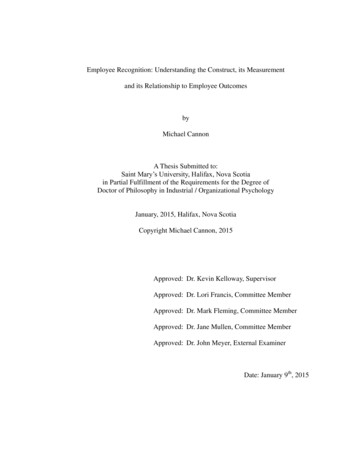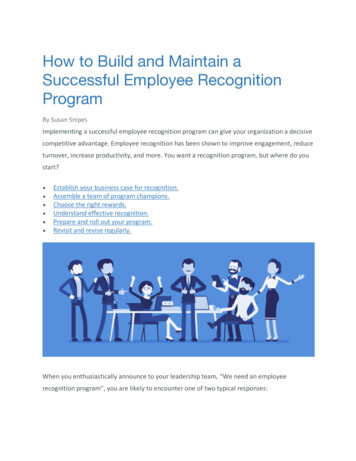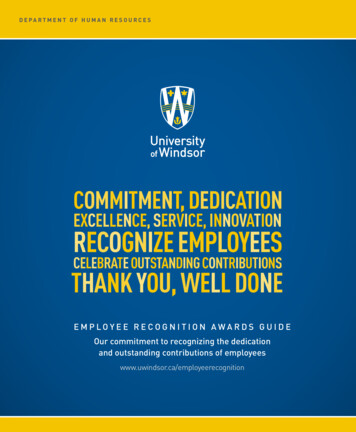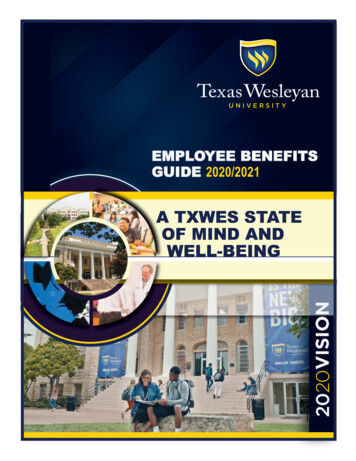
Transcription
Employee Recognition: Understanding the Construct, its Measurementand its Relationship to Employee OutcomesbyMichael CannonA Thesis Submitted to:Saint Mary’s University, Halifax, Nova Scotiain Partial Fulfillment of the Requirements for the Degree ofDoctor of Philosophy in Industrial / Organizational PsychologyJanuary, 2015, Halifax, Nova ScotiaCopyright Michael Cannon, 2015Approved: Dr. Kevin Kelloway, SupervisorApproved: Dr. Lori Francis, Committee MemberApproved: Dr. Mark Fleming, Committee MemberApproved: Dr. Jane Mullen, Committee MemberApproved: Dr. John Meyer, External ExaminerDate: January 9th, 2015
Employee Recognition2Table of ContentsAbstract . 3Employee Recognition: Understanding the Construct, its Measurement . 3Goals of the Current Research Project . 5Employee Recognition as a Social Exchange . 6The Importance of Employee Recognition . 9Recognition as a Form of Positive Feedback . 14The Construct of Employee Recognition . 15The Object of Recognition . 18Personal Recognition . 18Recognition of Achievement. 19Recognition of Work Performance. 20Recognition of Dedication . 20Recipient and Source of Recognition . 22Source of Recognition. 22Supervisor Recognition . 23Study 1: Survey Validation Study . 31Method . 39Participants . 39Measures . 40Procedure . 42Relation of Recognition to Various Outcomes . 49Linear Regression Analyses . 50Relationship between Recognition and Justice . 52Evidence of Discriminant Validity . 53Study 2: Vignette Study . 64Methods . 66Participants . 66Procedure and Measures . 66Results . 68Study 3: Diary Study . 82Procedure . 84Results . 84Mixed Model . 85Discussion: Diary Study . 90General Discussion . 94Avenues for Future Research . 101Conclusion . 102
Employee Recognition3AbstractEmployee Recognition: Understanding the Construct, its Measurementand its Relationship to Employee Outcomesby Michael CannonDespite its intuitive importance to organizational management, the concept of employeerecognition has received little systematic research attention. Because there is nogenerally accepted construct definition, different studies tend to rely on a variety ofconceptualizations and measures, the latter often being developed by the researchers forthat specific study. This has resulted in a sparse and disorganized collection ofknowledge regarding a construct that should be an essential component of any modernorganizations' HR management strategy, leaving many to rely on anecdotal evidence orpassing industry trends.The primary purpose of this research project was to establish an empirical basis onwhich future research could build. Using a conceptual definition put forth by Brun andDugas (2008), a measure of employee recognition was developed and validated. Resultsfrom research involving this scale suggest it is a valid and reliable measure of employeerecognition as a higher-order factor with four highly intercorrelated second-order facets.This measure can be used to predict outcomes such as organizational citizenshipbehaviors, organizational commitment, emotional well-being, turnover intention,perceived organizational support and self-rated job-performance.A vignette study demonstrated that while there may be a conceptual distinction betweenthe facets of recognition. Because they are highly correlated, it is difficult todiscriminate between the facets consistently. Therefore, it may be more effective tomeasure recognition as a higher-order factor, as evidenced by the fact that the differentdimensions tended to have similar effects on outcomes.Finally, an eight week diary study suggested that recognition predicts between-persondifferences in organizational citizenship behaviors (OCB), performance and emotionalwell-being, as well as longitudinal within-person changes in OCB and self-ratedperformance. Evidence generally indicated that recognition provides unique predictiveability over transformational leadership TFL. Taken together, the results of this researchproject support the use of recognition as an alternative or complementary predictor ofimportant employee outcomes.January 9th, 2015
Employee Recognition4Employee Recognition: Understanding the Construct, its Measurementand its Relationship to Employee OutcomesEmployee recognition has appeared sporadically in the researchliterature for over three decades, receiving attention from experts aiming to identifynew factors in employee performance and motivation (Godkin, Parayitam & Natarajan,2010; Magnus, 1981; ), as well as those interested in effective leader-followerrelationships (Luthans, 2000). More recently, recognition has been acknowledged as anintegral aspect of psychologically healthy workplaces (Grawitch, Gottschalk & Munz,2006). Not surprisingly, research also indicates that employees consider personalizedrecognition for the work they do to be an integral part of the rewards they receive atwork (Luthans, 2000). Employee recognition is widely recognized as an essential partof effective human resource management. However, results from a survey of 312North-American managers in the public sector showed that while the vast majorityagreed on the importance of recognition programs, barely half of them reported theexistence of formal employee recognition strategies in their own organizations(Saunderson, 2004).In an influential review, Grawitch, Gottschalk and Munz (2006) identified 5categories of healthy workplace practices: work-life balance, employee growth anddevelopment, health and safety, recognition and employee involvement. While some ofthese areas have received a considerable amount of research attention (ie: work-lifebalance, health & safety, employee development), relatively little research has focusedexclusively on employee recognition (see Tetrick & Haimann, 2014 for an overview).This lack of research, along with the general absence of a clear conceptual definition of
Employee Recognition5employee recognition has resulted in a somewhat vague and disconnected collection ofwork on the subject, considerably limiting our understanding of why and howrecognition affects key individual and organizational outcomes (Brun & Dugas, 2008).Goals of the Current Research ProjectGiven the lack of systematic research into employee recognition, my goal withthis thesis project was to help contribute to a conceptual base upon which futureresearch could build. One of the first issues I aimed to address was that of conceptualmeasurement. Because recognition can be defined in a number of ways, researcherstend to measure recognition in different ways, making it difficult to integrate variousresearch findings. Thus, the first goal of this project was to develop a scale of employeerecognition that could be used by future researchers. While recognition programs mayinclude financial incentives (i.e.: bonuses), non-financial awards or public recognition(Tetrick & Haimann, 2014), I chose to focus on interpersonal recognition coming froman employee’s supervisor. Immediate leaders tend to be in a unique position to providerecognition to employees because they have a formal position that allows (and mayeven require) them to recognize individual contributions. While peers can be animportant source of recognition, they may lack the formal authority to providerecognition on a regular basis. The organization and general public can also beimportant sources of recognition, but given their considerable social distance from theindividual, they may not be able to provide frequent individual recognition. Immediateleaders have both the formal authority and social proximity to individual employees.This helps make leaders a key source of recognition to research.The development of this scale also allowed me to investigate the factor structure
Employee Recognition6of recognition (as measured by the scale). Gaining a better understanding of themeasurement structure of recognition could have substantial implications for howorganizations and leaders develop recognition programs, as well as how professionalsin the organizational consulting field approach the subject of employee recognition.Next, my goal was to investigate the specific outcomes of recognition. While itseems intuitive to think that recognition will be associated with positive outcomes suchas motivation, satisfaction and commitment, the relatively sparse amount of existingresearch leaves both organizations and practitioners wanting in terms of understandingwhat the exact effects of recognition are, as well as how exactly these effects come tobe. Given my focus on recognition from one’s leader, it was necessary to assess therelationship between recognition and other key leadership attributes that are alreadywell established in the organizational literature (ie: transformational leadership).Employee Recognition as a Social ExchangeOf course, employee recognition is not a replacement for salaries and otherfinancial incentives. Employment is, after all, a transactional relationship whereindividuals exchange time, effort and expertise for money and other benefits. However,the employment relationship must also be recognized as a social exchange betweenindividuals and organizations, often represented by an employee’s immediate leader.Underlying this social exchange is the norm of reciprocity, which is one of the mostactively studied rules of social exchange (Colquitt et al., 2013). Simply stated,individuals who are treated fairly by another person or entity will usually feelcompelled to treat that person (or entity) fairly in return (Blau, 1964).Reciprocity is of central importance to understanding employee recognition
Employee Recognition7since it lies at the root of the bi-directional relationships employees share with theirsupervisors and organizations (Brun & Dugas, 2008). When employees dedicate timeand effort to completing a job, they are, in a sense, investing resources into theserelationships. In return, they expect certain tangible outcomes such as fair pay andbenefits. Employees also expect their employer to reciprocate with a number ofintangible resources in exchange, such as a safe work environment and respect, forexample. When organizations provide these, employees may feel a desire to reciprocatein turn with sustained effort and commitment to the organization. Once such exchangesbegin, they can develop into self-sustaining cycles where one party's actions elicit apositive reaction from the other, which in turn elicits another positive reaction in theinitial party (Cropanzano & Mitchell, 2005). In other words, when two parties respondto each-other's actions with appropriate, mutually beneficial behaviors, a high qualityrelationship often develops.Given the importance of non-financial resources and of reciprocity in thecontext of employee recognition coming from the immediate leader, Social ExchangeTheory (Blau, 1964) is one of the best-suited theoretical frameworks for research intohow the actions of organizations and supervisors produce a sense of social obligation inemployees (Wayne et al., 2002). However, the mechanisms through which these socialobligations are created remain somewhat uncertain. As Social Exchange Theory (SET)has been used to delve into workplace relationships, it has become apparent that certainevents in the workplace give rise to what have been termed social exchangerelationships which in turn shape future interactions, as well as individual attitudes andbehaviors (Cropanzano, Byrne, Bobocel & Rupp, 2001).
Employee Recognition8Although there has been a limited amount of coordinated research focusingdirectly on employee recognition, much can be inferred from our knowledge of relatedconstructs, such as organizational justice. Following a number of influential metaanalyses around the turn of the century (e.g.: Cohen-Charash & Spector, 2001;Viswesvaran & Ones, 2002) and a subsequent onslaught of research, Social ExchangeTheory (SET; Blau, 1964) has emerged as one of the primary theoretical contextswithin which to understand how justice affects such individual outcomes as turnoverintention and organizational citizenship behaviours (OCB) (Cropanzano & Mitchell,2005). In fact, some would argue that SET is “among the most influential conceptualparadigms for understanding workplace behaviours” (Cropanzano & Mitchell, 2005, p.874). According to SET, different social parties exchange various types of resourcesbased on certain rules or norms (Colquitt et al., 2013). These resources can beeconomic (ie: money) and socio-emotional (Foa & Foa, 1974; 1980). Socio-emotionalresources tend to be largely symbolic in nature and tend to nurture the individual's senseof self-esteem (Cropanzano & Mitchell, 2005). They are particularly relevant toemployee recognition, since the social exchanges between employees and theirsupervisors are not typically based on economic resources. When supervisors take thetime to recognize an employee's accomplishments or positive attitude, they are in effectproviding certain socio-emotional resources (appreciation, public recognition, etc.) thathelp sustain a positive sense of self-esteem in employees.Based on the norm of reciprocity, employees who perceive their supervisor asinvesting resources into their interpersonal relationship will seek to return the favourwith other socio-emotional resources, such as sustained effort, positive workplace
Employee Recognition9behaviours, or loyalty. This provides supervisors with an opportunity to renew theexchange cycle by reciprocating with further recognition and appreciation. At each stepof the process, one party's action elicits a reaction from the other. As long as thesereactions are positive and appropriate, the cycle is self-reinforcing in nature(Cropanzano & Mitchell, 2005). In the context of organizational justice, employeeswho feel they are being treated fairly by their organization may similarly reciprocatewith improved task performance and organizational citizenship behaviours (OCB).Similarly, employees who feel their contributions are being adequately recognizescould be expected to behave in a similar way. While we are at a relatively early stage inresearching employee recognition, it appears that Social Exchange Theory can providean informative context within which to interpret the effect of recognition on importantindividual and organizational outcomes.The Importance of Employee RecognitionDespite the inherent limitations in the existing literature, a quick overview ofexisting work suffices to demonstrate the importance of employee recognition inmodern organizational life. As work continues to play a more important role in howpeople define themselves and the lives they lead, the perceived value of this workimpacts not only their sense of identity, but also their overall well-being. It thus followsthat individuals use both internal and external information in ascertaining the value oftheir various contributions. In this sense, employee recognition is an important form of(positive) feedback, providing key information to employees regarding successfulperformance of both in- and extra-role behavior. While employee recognition can takenumerous forms, one of the uniting features of the variations is the fact that recognition
Employee Recognition10communicates to the individual that they are valued by their colleagues, leader, and / ororganization (Tetrick & Haimann, 2014). The role of recognition as a form of feedbackwill be further discussed in a following section.Recognition and Motivation. Information regarding the value of anindividual’s contributions has an impact on a variety of outcomes. One of the mostimportant individual outcomes driving organizational interventions is motivation. Theneed to sustain a motivated workforce drives substantial financial and researchinvestment. In fact, it could be argued that one of the driving forces behind the field ofOrganizational Psychology is the desire to achieve increased levels of performancethrough motivation. Employees' level of motivation will increase when they feel thatthey, as individuals, together with the work they do, are valued by others (Amabile &Framer, 2007). This highlights the importance of employee recognition as a primarysource of information regarding the value of an employee's contributions to theorganization. Feeling that one commands respect and esteem from others is a centralelement in Maslow’s (1943) hierarchy of needs. Thus, it follows that leaders andorganizations who take the time to communicate this esteem to employees help increasemotivation by creating an environment that satisfies a key human psychological need.The notion that psychological needs drive workplace performance has drawnconsiderable research attention over the last 30 years, helping to shift focus away fromthe purely financial or material motivators that organizations have relied on for so long.Of course, the motivational role of employee recognition should come as nosurprise, since this is the underlying reason organizations invest in developingemployee recognition programs. Empirical research has consistently demonstrated that
Employee Recognition11employee recognition is associated with higher levels of employee engagement,motivation and satisfaction (Krueger et al., 2002; Siraz, Rashid & Riaz, 2011). In fact, ameta-analysis by Stajkovic and Luthans (2003) involving roughly 70 studies providesclear support for the idea that recognition in the form of financial rewards, positivefeedback and social recognition is linked with increased levels of job performance.Perhaps not surprisingly, employees who feel their contributions are recognized alsotend to experience higher levels of job-satisfaction, another key outcome inorganizational research (Kooij, Jansen, Dikkers & De Lange, 2010).Self-determination theory (SDT) is an important theory of motivation thatrecognizes that humans are active, growth-oriented beings (Deci & Ryan, 2000). One ofthe primary contributions of this theoretical approach to motivation is the fact that itdraws a clear conceptual link between employee motivation and psychological wellbeing, arguably two of the most important individual outcomes in organizationalresearch. This theory focuses on three innate psychological needs: competence,autonomy and relatedness, which are critical for achieving intrinsic motivation andhealthy psychological functioning (Ryan & Deci, 2000). According to Ryan and Deci(2000), a basic need is “an energizing state that if satisfied, conduces toward health andwell-being but if not satisfied, contributes to pathology and ill-being” (p. 74). Becauseof its emphasis on human flourishing, and its well established usefulness inunderstanding mental health and motivation, self-determination theory provides aninteresting theoretical framework within that to understand the effects of employeerecognition.Recognition is closely related to the fundamental psychological need for
Employee Recognition12competence stipulated in Self-Determination Theory (Ryan & Deci, 2000). Individualswhose work allows them to feel competent will be more intrinsically motivated by thiswork, which will lead to higher levels of performance. As noted above, recognitionplays a key role in providing information to individuals about their contributions,thereby bolstering feelings of competence. This provides leaders with a greatopportunity to foster motivation in employees by identifying specific examples ofcompetence and communicating these back to the individual.Another key motivating force according to SDT is the need for relatedness(Ryan & Deci, 2000). Individuals tend to be more intrinsically motivated to engage inactivities that make them feel related to others. In a way, recognition helps to achievethis by making employees feel that they are valued by others in their organization. Theneed for relatedness represents an innate need to be “securely connected to andesteemed by others, and to belong to a larger social whole” (Ryan & Stolky, 1996, p.251). By helping to foster a healthy relationship between supervisor and employee,recognition helps the individual to feel that their work connects them to others, as wellas their organization, that is often most directly represented by the immediate leader.Thus, there appears to be a considerable theoretical basis for the motivational benefitsof employee recognition.Recognition and Psychological Well-Being. A lack of recognition may alsoplace employees at greater risk of experiencing psychological distress (Ryan & Deci,2000; Brun et al., 2003). As noted above, recognition helps to satisfy key psychologicalneeds such as the need for competence and relatedness that allow individualpsychological health to flourish. A number of studies linking recognition to
Employee Recognition13psychological well-being have also used the framework of Job Demands-Resources(JDR; Bakker & Demerouti, 2007), which states that employees’ jobs require them toinvest certain physical, psychological and social resources (see Tetrick & Haimann,2014 for a more in-depth discussion of recognition & JDR). Because these resourcesare finite in nature, individuals who expend their physical / mental energy to meet thedemands of their jobs may find themselves feeling depleted. Conversely, individualsalso have a number of resources at their disposal via their job, which enable them tomanage the demands of their work successfully. While job-demands deplete anemployee’s physical and psychological energy, these resources help to replenish theindividual, fostering heightened levels of motivation and well-being (Bakker &Demerouti, 2007). Employee recognition represents an important resource that helpsprovide positive information regarding an individual’s contributions. This recognitioncommunicates to the individual that they are making meaningful contributions and thatthese contributions are valued by others. This represents an important form ofpsychological resource that may help individuals to better deal with the stress arisingfrom their work.In one study, employees who received recognition in the form of appreciationand / or bonuses tended to experience lower levels of psychological distress (Gelsemaet al., 2005). Research has also demonstrated that individuals who are adequatelyrecognized for their contributions experience a lower level of emotional exhaustion(Macky & Boxell, 2008). Thus, it appears the key benefits of employee recognition aretwo-fold, affecting motivation ( thereby leading to increased performance) as well asfostering psychological well-being in employees. Of course, additional research is
Employee Recognition14needed, since results in some studies have not been consistent with the expectedpatterns. For example, Grawitch, Trares, and Kohler (2007) found a positiverelationship between employee recognition and emotional exhaustion (these results willbe further discussed later).Recognition as a Form of Positive FeedbackAs previously noted, recognition is a form of positive feedback as it isinherently a (positive) value judgement about some aspect of an employee’s workplacecontributions. Like feedback, the ideal form of recognition should be based on specificbehaviors or characteristics, clearly identifying the desired contribution that is, in asense, being rewarded with recognition. Although recognition need not include anexplicit statement of thanks, it necessarily involves an acknowledgement andappreciation of an individual’s work. Thus, within a behavioral context, employeerecognition can be understood as a consequence of an individual’s behavior or, in somecases, characteristics and other contributions.More specifically, recognition can be understood within the context of operantconditioning (Skinner, 1953). According to this perspective, associations are createdbetween certain behaviors and their outcomes or consequences. Individuals aremotivated to perform behaviors for which they have been rewarded in the past and willavoid engaging in behaviors that have previously led to punishment. When certainbehaviors are recognized by one’s colleagues, leader or organization, these behaviorsbecome more likely to re-occur. As such, recognition is an important way that leaderscan motivate employees to continue engaging in positive behaviors that generatemeaningful contributions to the organization.
Employee Recognition15Effective feedback should be delivered as soon as possible after the relevantevent. The issue of timing has substantial implications for the effectiveness of manyrecognition programs. In many cases, recognition is provided after a considerable delay(ie: yearly bonuses, annual awards, etc.). While these types of recognition maynonetheless be much appreciated by individuals, it is feasible that their effect may bediluted by the delay between the actual behavior and the recognition for the behavior.This especially highlights the value of interpersonal feedback from immediatesupervisors (the primary focus of this research project) since supervisors tend to be in aunique position that allows them to observe desired behavior and administer feedbackimmediately. Thus, training leaders to effectively recognize opportunities to providerecognition is crucial if individuals are to be recognized with relative immediacy.The Construct of Employee RecognitionDespite a growing interest over the past decade, our understanding of employeerecognition and its effects is still quite restricted. For example, as a central componentof healthy workplace practices, employee recognition programs would be expected tohave a positive effect on individual well-being, performance and related organizationaloutcomes. However, results have been mixed. In one study of healthy workplacepractices, satisfaction with employee recognition programs had a positive correlationwith organizational commitment (r .39, p .05) and a negative correlation withturnover intentions (r -.23, p .05), as would be expected of any healthy workplacepractice (Grawitch, Trares, & Kohler, 2007). However, it also had a positive correlationwith emotional exhaustion (r .22, p .05). Furthermore, the relationship betweenrecognition and turnover intention became positive when other predictors were included
Employee Recognition16as part of a regression analysis, indicating suppression effects for the recognitionturnover intent relationship. However, when employee involvement (arguably the mostimportant component of all healthy workplace practices; Grawitch et al., 2009) wasremoved from the regression analysis, the suppression effects on employee r
recognition that could be used by future researchers. While recognition programs may include financial incentives (i.e.: bonuses), non-financial awards or public recognition (Tetrick & Haimann, 2014), I chose to focus on interpersonal recognition coming from an employee's supervisor. Immediate leaders tend to be in a unique position to provide










